Abstract
PAH contamination from coking plants have received widespread attention. However, the microbial diversity, co-occurrence patterns, and functional genes of bacteria in aged coking contaminated soils by PAHs are still not clear. In our study, we used a macro-genetic approach to detect PAH-contaminated soils from both a coking production area (CA group) and an office zone (OA group) in an abandoned coking plant, and analyzed the characteristic bacteria and function genes, microbial network interaction patterns, and soil P-cycling in long-term PAH-contaminated soils. The results revealed that Proteobacteria were significantly positively correlated with PAHs and Betaprobacteria bacterium rifcsplowo2 12 full 6514, candidatus Muproteobacteria bacterium RBG16609, and Sulfurifustis variabilis, which belong to Proteobacteria, were characteristic bacteria in PAH-contaminated soils. The phn, which is the PAH degradation gene, was abundantly expressed in the PAH-contaminated soil. The phn gene cluster genes (phnE, phnC, and phnD) were significantly expressed in the CA group of PAH-contaminated soils (p < 0.05). By integrating microbial diversity, network structure, and functional genes, it offers a comprehensive understanding of soil ecosystem response indicators to prolonged PAH stress. The results of this study will provide new ideas for constructing an assessment index system for soil health and screening biomarkers for PAH-contaminated soils.
1. Introduction
Polycyclic aromatic hydrocarbons (PAHs) are a class of organic compounds composed of two or more condensed benzene rings. PAHs in the environment can enter the human body through various pathways, so the treatment and remediation of PAH pollution has received widespread attention. PAH contamination in the soil environment comes from a wide range of sources, among which the dispersal or seepage of petroleum compounds containing PAHs from coking plants is one of the most important sources [1,2,3].
PAHs are divided into two categories: low molecular weight (LMW) compounds composed of fewer than four rings and high molecular weight (HMW) compounds of four or more rings. The higher the molecular weight of the PAHs, the more stable and hydrophobic they are [4]. So, they are not easily degradable and can remain in soil, sediment, and atmospheric particles for a long time, causing persistent environmental pollution. Considering the economic benefits and high efficiency of microbial remediation, it has become an ideal method and an important means of removing PAHs from the environment [5]. Researchers have isolated a variety of PAH-degrading bacteria from the environment, including Pseudomonas, Rhodococcus, Aeromonas, Bacillus, Burkholderia, Mycobacterium, and Sphingomonas etc. [6], but there are not many efficient degrading strains covered in them, especially the high-ring PAH-degrading bacteria, which are even rarer. Therefore, it is of great practical significance to screen for efficient PAH-degrading bacteria or mixed strains.
In this study, we used gene sequencing to perform a macro-genomic analysis of bacterial communities in aged PAH-contaminated soil from an abandoned coking plant. We analyzed the correlations between the soil bacterial community and PAHs. The main objective of this study was to investigate the structure and characteristic genes of soil bacterial communities with long-term PAH contamination, with special focus on (i) bacterial diversity and characteristic genes of PAH-contaminated soils; (ii) soil microbial interactions in soils from the coking plant; (iii) the effect of PAH contamination on the function of soil microbial-mediated phosphorus cycling. The changes in the soil community structure and microbial functional genes under long-term stress of PAHs were investigated in the soil of an abandoned coking plant. The results of this study will provide new ideas for constructing an assessment index system for soil health and screening biomarkers for PAH-contaminated soils.
2. Materials and Methods
2.1. Sample Collection
Our study investigated an old, abandoned coking plant in eastern China (Figure 1). To meet the needs of urbanization and development, the coking plant ceased production in 2015, and most of the production equipment in the plant has been dismantled. Soil samples were collected following HJ/T166-2004 [7] We collected four soil samples at the coking production area (CA, S1–S4) and four soil samples at the office area (OA, S6–S8) of the site in the winter of 2022. Each sample was a mixture of five soil cores (0–15 cm) from a 1 × 1 m2 area at the sampling point. The soil samples were collected in sterile bottles insulated with dry ice and sent to the laboratory to be stored at −80 °C for microbiological and soil chemical analysis.
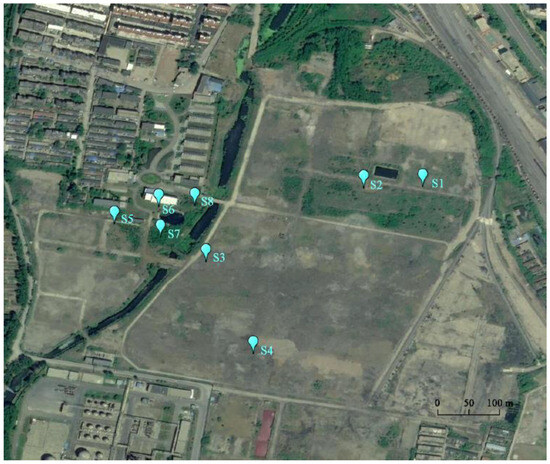
Figure 1.
Remote sensing image of the study area.
2.2. PAH Analysis
The 16 PAHs prioritized for control by the U.S. EPA were extracted according to the standard method (HJ834-2017) [8]. A total of 10 g of soil samples were weighed and diatomaceous earth was added to grind them into a fine powder. The resulting sample was then transferred to an ASE accelerated solvent extractor (E-916, Stepqi Laboratory Instruments Ltd., Uster, Switzerland), and 6 mix surrogates (2-fluorophenol, 2-fluorobiphenyl, phenol-D6, nitrobenzene-D5, 2,4,6-tribromophenol, and p-tertiary-D14) were added, and a mixture of dichloromethane and acetone (1:1, V:V) was used for the extraction. After extraction and filtration, the concentration was concentrated to 1 mL in a water bath, and then the internal standard (a mixture of six deuterated PAHs) was added. PAHs were analyzed by gas chromatography–mass spectrometry (GC–MS) (7890B-5977B, Agilent Technologies, Inc., Santa Clara, CA, USA) and qualitatively analyzed based on ion fragmentation and retention time, and quantified by the quantitative ion internal standard method. Quality control follows HJ834-2017. Laboratory blanks and laboratory parallels were used with 6 mix surrogates (2-fluorophenol, 2-fluorobiphenyl, phenol-D6, nitrobenzene-D5, 2,4,6-tribromophenol, and p-tertiary-D14), and the standards used for QC consisted of 6 mix surrogates and 64-component semivolatile mixture standards.
2.3. DNA Extraction and Metagenome Sequencing Analysis
The total DNA was extracted from the soil using a Magnetic Soil And Stool DNA Kit (TIANGEN, Beijing, China) according to the manufacturer’s instructions. The DNA sample was fragmented by sonication to a size of 350 bp, then DNA fragments were end-polished, A-tailed, and ligated with the full-length adaptor for Illumina sequencing with further PCR amplification. At last, PCR products were purified using the AMPure XP system, and libraries were analyzed for size distribution by the Agilent 2100 Bioanalyzer and quantified using real-time PCR (Bio-Rad CFX96, Hercules, CA, USA). The clustering of the index-coded samples was performed on a cBot Cluster Generation System according to the manufacturer’s instructions. After cluster generation, the library preparations were sequenced on an Illumina Novaseq 6000 (Illumina, San Diego, CA, USA), generating 150 bp paired-end reads. The data generated from the Illumina (or BGI) platform were used for bioinformatics analysis. The extraction and sequencing methods of total DNA are described in Supplementary Materials. All of the analyses and quality control were performed by Shanghai Applied Protein Technology (Shanghai, China).
2.4. Data Analysis
SPSS Statistical Package 17.0 (IBM, New York, NY, USA) and Excel 2020 (Microsoft, Redmond, WA, USA) were used to process the data. The network was visualized in Gephi version 0.10.1 [9]. R software (3.5.3 version) was used to carry out PCoA and Lefse (p < 0.05 and an LDA score > 3) analyses. The R language package(PCoA: stats 4.2.2 and LEfSe 1.1.01) is in the Supplementary Materials.
3. Results
3.1. Concentration Distributions of PAHs
The highest content of total PAHs was found in S3 (554.05 mg/kg), and the lowest was in S7 (3.27 mg/kg) (Supplementary Materials, Table S1). We used the Mann–Whitney test to analyze the PAHs in two areas (coking production area and office area), the result showed that there was a significant difference (p < 0.05) between the two areas (Supplementary Materials, Table S2). Additionally, the PAHs in all the samples were dominated by high molecular weight (HMW) PAHs, accounting for 65.72% to 83.86% of the total (Figure 2).
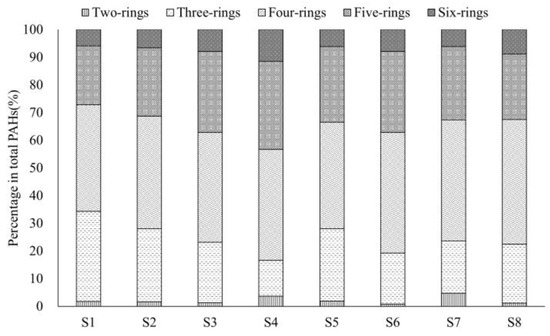
Figure 2.
Distribution of PAHs depending on the number of rings in the molecule.
3.2. Relationship Between Bacterial Communities and PAHs
Both LMW-PAHs and HMW-PAHs were significantly positively correlated with Proteobacteria and Aciddobacteria (p < 0.05) (Figure 3). Furthermore, Proteobacteria showed a positive correlation with Chloroflexi and Gemmatimonadetes (p < 0.05). Principal coordinates analysis (PCoA) of the soil communities revealed that the similarities between the phylum types of CA and OA were significantly different (Supplementary Materials, Figure S1). The findings reveal the existence of characteristic microorganisms that have adapted to this stressful environment in PAH-contaminated soil, and the results of the study indicate the characteristics of these microbial phyla in the biodegradation of soil PAHs.
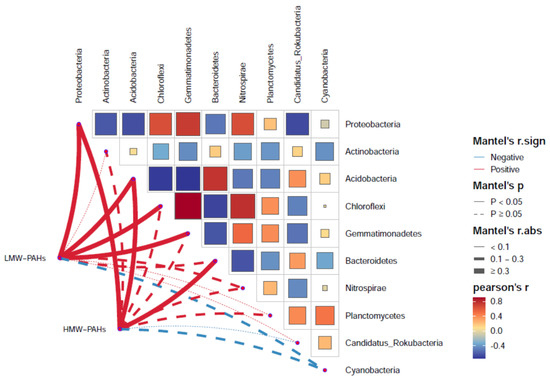
Figure 3.
Correlation between the top 10 phylum and PAHs.
There were significant differences between the CA and OA groups at the species level (p < 0.05) (Supplementary Materials, Figure S2). Lefse analysis identified significantly different species markers in the CA group (Figure 4), primarily comprising of the following: Chloroflexi bacterium RGB 16070013/167214, Gemmatimonadetes bacterium, Betaprobacteria bacterium rifcsplowo2 12 full 6514, candidatus Muproteobacteria bacterium RBG16609, and Sulfurifustis variabilis. These findings are consistent with the results of our study.
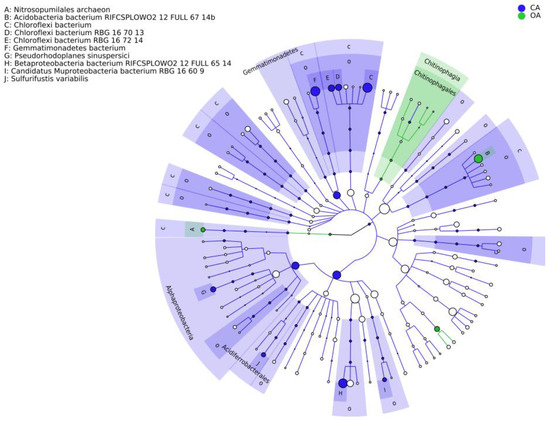
Figure 4.
Annotated branching map of different species.
3.3. Co-Occurrence Network Analysis
The network analysis was used to explore the co-occurrence patterns in soil microbial communities (Figure 5). The co-occurrence network had a total of 199 nodes and 2356 edges, with a modularity index of 3.74 (a value > 0.4 indicates that the network has a modular structure). The highly related microorganisms in the soil bacterial co-occurrence network were mainly categorized into three larger modules (Figure 5a), accounting for 41.71%, 36.68%, and 15.58%. The co-occurrence network nodes were mainly Proteobacteria (40.1%), Acidobacteria (7.11%), Actinobacteria (31.98%), Chloroflexi (5.58%), and Gemmatimonadetes (4.06%) (Figure 5b). According to the betweenness centrality of the association network [10], Phycicoccus_jejuensis, Nocardioides_sp_LS1, Cyanobacteria_bacterium_13_1_40 CM_2_61_ 4, and Nitriliruptor_alkaliphilus were identified as key taxa, suggesting that these microorganisms play a key role in the co-occurrence network.
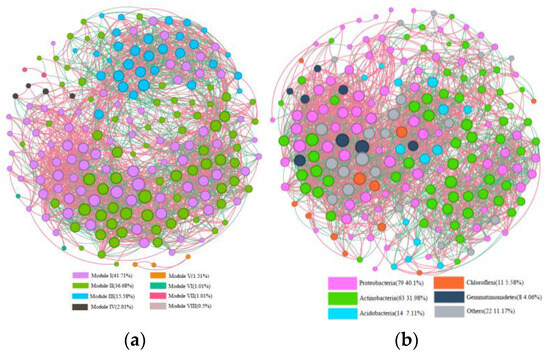
Figure 5.
Co-occurrence networks of microbial communities. (a) Different modularity classes; (b) node colors indicate different phyla. The red line means positive correlation and the green line means negative correlation.
3.4. Functional Gene of Soil Phosphorus Cycling and PAH Degradation
The soil phosphorus cycle is a key component of the Earth’s biogeochemical cycles and is essential for maintaining ecosystem function, supporting plant growth, and ensuring the healthy functioning of the global food chain [11,12]. Soil microorganisms are able to make phosphorus more readily available for plant uptake by solubilizing insoluble phosphorus compounds [13]. At the same time, microorganisms are also able to increase the bioavailability of phosphorus by converting organic phosphorus into an inorganic form, a process known as mineralization.
Principal coordinates analysis (PCoA) was performed on the microbiological phosphorus functional genes of the studied soils (Supplementary Materials, Figure S3). There was a significant difference in the first principal component between the CA and OA groups, indicating that the phosphorus functional genes of soil microorganisms in the two groups differed. The differential genes of the two groups based on relative abundance (Mann–Whitney–Wilcoxon test, Figure 6) showed that the phoD functional gene in the OA group was significantly higher (p < 0.05). The phoD gene is widely reported among the microorganisms involved in the soil phosphorus cycle [11], and these microorganisms play an important role in soil phosphorus conversion and utilization by secreting alkaline phosphatase. Phosphatase is concerned with hydrolyzing organic phosphorus compounds in the soil phosphorus cycle and converting them into inorganic forms of phosphorus that can be absorbed and utilized by plants, thus increasing the bioavailability of soil phosphorus [14]. The results of our study showed that soil alkaline phosphatase gene abundance was higher in the OA group, which could be because the phosphorus metabolic cycling ability of soils in the OA group was better. The metabolic cycling of soil phosphorus was inhibited in the CA group.
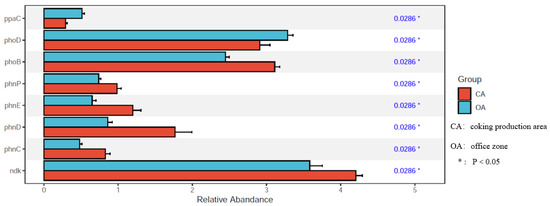
Figure 6.
Significantly different functional genes.
Meanwhile, the relative abundance of phnP, phnE, phnC, and phnD genes, which belong to the phn gene cluster, in CA was significantly higher (p < 0.05). The phn gene cluster comprises a group of tightly spaced genes that are relatively centralized on the chromosome, and collectively encode the enzymes and auxiliary proteins involved in the degradation of aromatic compounds [15]. It has been reported that the phn genes of the burkholderia cepacia RP007 strain constitute a cluster of genes involved in the catabolism and metabolism of polycyclic aromatic hydrocarbons. These genes are transcribed and the recombinant phn enzyme is able to oxidatively metabolize naphthalene and phenanthrene when the RP007 strain needs to consume them in its growth process [16]. Researchers have identified the genes for the entire catabolic pathway of phenanthrene through the phylogeny of the cyclic hydroxylated dioxygenase (RHD) that initiates bacterial PAH metabolism on a new genomic island (GEI) approximately 232 kb long, referred to as the phn island [17]. The presence or absence of the phn gene and the level of its expression can also be used as an indicator of an environmental pollutant’s degradation capacity. By detecting the expression of the phn gene in a specific environment, the degradation capacity of the environment for PAHs and chlorinated aromatic compounds can be assessed, providing a scientific basis for environmental monitoring and assessment.
4. Discussion
Macro-genome sequencing was performed on soils from an abandoned coking plant to understand the soil community structure and biomarkers under long-term PAH stress. The results of the microbial community composition were similar to those of Shuying Geng [7] in the soil of an abandoned chemical plant. Geng found that the dominant phyla in all samples were responsible for PAH degradation and included Proteobacteria (20.86–81.37%) and Chloroflexi (2.03–28.44%) [7]. Tang reported that microbial diversity analysis of PAH-contaminated deep soil from a chemical plant showed that the dominant phyla degrading PAHs were Pseudomonas and Acinetobacter [18]. The genera Enterobacteria and Pseudomonas, which belong to the gamma-proteobacteria, played a major role in the degradation of PAHs in a coal tar-contaminated soil [19]. Our study found that PAHs were significantly positively correlated with Proteobacteria and Acidobacteria (p < 0.05). The results indicated the presence of the characteristic bacteria in long-term PAH-contaminated soils to adapt to the long-term stress of PAHs and for soil self-purification. Meanwhile, soil microflora is a complex network interaction system, and the results showed that the Phycicoccus_jejuensis, Nocardioides_sp_LS1, Cyanobacteria_bacterium_13_1_40 CM_2_61_4, and Nitriliruptor_ alkaliphilus were key taxa. Similarly, Yiyi Zhao found that key species may influence microbial assemblage patterns through synergistic interactions [20]. Research has shown that PAH-degrading bacteria (PDB) from various depths of a chemical waste land soil belonged to Actinomycetes and Proteobacteria, which dominated the bacterial communities during the early and full stages of the biopurification process [21]. Keystone species can influence the composition and aggregation of the microbial communities [22,23]. Many studies have reported that the keystone species are likely to play important roles in caring for microbial network structure of soil [24,25,26]. Briefly, the biodegradation of PAHs requires interactions and co-adaptation between soil bacterial communities [27,28].
Microorganisms generally produce a series of metabolic reactions through the expression of specific degradation genes and degradation enzymes, which in turn lead to the transformation and degradation of PAHs [29]. Degradation genes encode enzymes, mainly including dioxygenases, hydratases, aldolases, and dehydrogenases [30]. According to the current study, microorganisms have PAH degradation genes, mainly including nid, phd, nah, phn, and pdo. In the present study, it was found that the phn gene was abundantly expressed in the PAH-contaminated soil of the coking area, and the phn gene mainly encodes a dioxygenase, which achieves the carboxylation of the aromatic ring for the degradation of naphthalene, phenanthrene, pyrene, and other PAHs [31,32,33,34].
What is a healthy soil? Professor Larkin [35] proposed the concept of soil health, which includes an indicator as soil having some resistance and resilience to environmental degradation and stress. The Cornell Soil Health Evaluation System [36] also suggests that healthy soils should be easy to farm and can be resistant to unfavorable environments. Maintaining soil health, exploring soil multi functionality, and developing soil green products are the keys to enhancing sustainable soil development and human One Health unification [37]. In the present study, soil microorganisms adopted adaptive strategies to survive under prolonged and high concentrations of PAHs, and evolved characteristic bacterial communities [38,39,40,41]. Healthy soil should be uncontaminated and rich in beneficial microbial species involved in nutrient cycling and organic matter decomposition functions. In contrast, the microbial communities of the polluted soil in the coking plant were changed, which provides a reference for the index system of soil health evaluation. Furthermore, the evaluation system of soil health should include biological indicators such as the soil microbial community structure of healthy soil.
5. Conclusions
This study provides new insights into the structural characteristics of soil bacterial communities under long-term stress from PAHs. Proteobacteria were significantly positively correlated with PAHs and Betaprobacteria bacterium rifcsplowo2 12 full 6514, candidatus Muproteobacteria bacterium RBG16609, and Sulfurifustis variabilis, which belong to Proteobacteria, were characteristic bacteria in PAH-contaminated soils. The phn, which is the PAH degradation gene, was abundantly expressed in the PAH-contaminated soil. By integrating microbial diversity, network structure, and functional genes, it offers a comprehensive understanding of soil ecosystem response indicators to prolonged PAH stress. The findings of this study will provide new perspectives for constructing an assessment index system for soil health and screening biomarkers for PAH-contaminated soils at coking plants.
Supplementary Materials
The following supporting information can be downloaded at: https://www.mdpi.com/article/10.3390/microorganisms13040869/s1, Figure S1: Principal coordinates analysis of Phylum; Figure S2: Anosim analysis based on species level; Figure S3: PCoA analysis of phosphorus functional genes; Table S1: PAHs contents in sample soil; Table S2: Mann-Whitney Test [42,43].
Author Contributions
Conceptualization, B.Z.; Methodology, L.X.; Formal analysis, J.D.; Investigation, L.Z.; Resources, Q.L.; Writing—review & editing, Y.Y.; Visualization, X.L.; Supervision, Q.X. and A.Z.; Funding acquisition, Y.C. All authors have read and agreed to the published version of the manuscript.
Funding
This work was supported by the National Natural Science Foundation of China (Nos. 22206202 and 22076216) and the National Key Research and Development Program of China (Nos. 2018YFC1801100 and 2018YFC1801103).
Institutional Review Board Statement
Not applicable.
Informed Consent Statement
Not applicable.
Data Availability Statement
The original contributions presented in this study are included in the article. Further inquiries can be directed to the corresponding author.
Acknowledgments
Special thanks to Applied Protein Technology Company, China for providing assistance in microbiome sequencing and soil metabolomic study.
Conflicts of Interest
The authors declare no conflicts of interest.
References
- Cao, W.; Geng, S.; Zou, J.; Wang, Y.; Guo, Y.; Zhu, Y.; Dou, J. Post relocation of industrial sites for decades: Ascertain sources and human risk assessment of soil polycyclic aromatic hydrocarbons. Ecotoxicol. Environ. Saf. 2020, 198, 110646. [Google Scholar] [CrossRef] [PubMed]
- Xu, S.S.; Liu, W.X.; Tao, S. Emission of polycyclic aromatic hydrocarbons in China. Environ. Sci. Technol. 2006, 40, 702–708. [Google Scholar] [CrossRef]
- Jiao, S.; Liu, Z.; Lin, Y.; Yang, J.; Chen, W.; Wei, G. Bacterial communities in oil contaminated soils: Biogeography and co-occurrence patterns. Soil Biol. Biochem. 2016, 98, 64–73. [Google Scholar] [CrossRef]
- Zhang, Y.X.; Tao, S. Global atmospheric emission inventory of polycyclic aromatic hydrocarbons (PAHs) for 2004. Atmos. Environ. 2009, 43, 812–819. [Google Scholar] [CrossRef]
- Seo, J.S.; Keum, Y.S.; Li, Q.X. Bacterial degradation of aromatic compounds. Int. J. Environ. Res. Public Health 2009, 6, 278–309. [Google Scholar] [CrossRef]
- Rockne, K.J.; Strand, S.E. Anaerobic biodegradation of naphthalene, phenanthrene, and biphenyl by a denitrifying enrichment culture. Water Res. 2001, 35, 291–299. [Google Scholar] [CrossRef]
- HJ/T 166-2004; The Technical Specification for Soil Environmental Monitoring. Ministry of Ecology and Environment of the People’s Republic of China: Beijing, China, 2004.
- HJ 834-2017; Soil and Sediment-Determination of Semivolatile Organic Compounds- Gas Chromatography/Mass Spectrometry. Ministry of Ecology and Environment of the People’s Republic of China: Beijing, China, 2017.
- Li, X.; Qu, C.S.; Bian, Y.R.; Gu, C.G.; Jiang, X.; Song, Y. New insights into the responses of soil microorganisms to polycyclic aromatic hydrocarbon stress by combining enzyme activity and sequencing analysis with metabolomics. Environ. Pollut. 2019, 255, 113312. [Google Scholar] [CrossRef]
- Tang, L.; Zhao, X.; Chen, X.; Jiang, Y.; Gudda, F.; Wang, Y.; Ling, W. Distribution of bound-PAH residues and their correlations with the bacterial community at different depths of soil from an abandoned chemical plant site. J. Hazard. Mater. 2023, 453, 131328. [Google Scholar] [CrossRef]
- Zhang, S.; Hu, Z.; Wang, H. Metagenomic analysis exhibited the co-metabolism of polycyclic aromatic hydrocarbons by bacterial community from estuarine sediment. Environ. Int. 2019, 129, 308–319. [Google Scholar] [CrossRef]
- Wang, C.; Wang, D.; Li, Y.; Liu, S. Metagenomics of the Effect of Long-Term Straw Return on the Phosphorus Cycle in Meadow Black Soil. Agronomy 2023, 13, 3003. [Google Scholar] [CrossRef]
- Zhao, Y.; Li, Y.; Yang, F. Critical review on soil phosphorus migration and transformation under freezing-thawing cycles and typical regulatory measurements. Sci. Total Environ. 2021, 751, 141614. [Google Scholar] [CrossRef] [PubMed]
- Turner, B.L.; Lambers, H.; Condron, L.M.; Cramer, M.D.; Leake, J.R.; Richardson, A.E.; Smith, S.E. Soil microbial biomass and the fate of phosphorus during long-term ecosystem development. Plant Soil 2012, 367, 225–234. [Google Scholar] [CrossRef]
- Hy’sek, J.; Sˇarapatka, B. Relationship between phosphatase active bacteria and phosphatase activities in forest soils. Biol. Fertil. Soils 1998, 26, 112–115. [Google Scholar]
- Sivabalan, S.; Shanmuganathan, R.; Thanigaivelan, K.; Dakshina, B.; Rajkumar, P.; Sivanesan, D. Biocatalytic Potential of Pseudomonas Species in the Degradation of Polycyclic Aromatic Hydrocarbons. J. Basic Microbiol. 2024, 29, 2400448. [Google Scholar] [CrossRef]
- Laurie, A.D.; Lloyd-Jones, G. The phn Genes of Burkholderia sp. Strain RP007 Constitute a Divergent Gene Cluster for Polycyclic Aromatic Hydrocarbon Catabolism. J. Bacteriol. 1999, 181, 531–540. [Google Scholar] [CrossRef]
- Barbera’n, A.; Bates, S.T.; Casamayor, E.O.; Fierer, N. Using network analysis to explore co-occurrence patterns in soil microbial communities. ISME J. 2011, 6, 343–351. [Google Scholar] [CrossRef]
- Hickey, W.J.; Chen, S.; Zhao, J. The phn Island: A New Genomic Island Encoding Catabolism of Polynuclear Aromatic Hydrocarbons. Front. Microbiol. 2021, 3, 125. [Google Scholar] [CrossRef]
- Lors, C.; Ryngaert, A.; Perie, F.; Diels, L.; Damidot, D. Evolution of bacterial community during bioremediation of PAHs in a coal tar contaminated soil. Chemosphere 2010, 81, 1263–1271. [Google Scholar] [CrossRef]
- Geng, S.; Cao, W.; Yuan, J.; Wang, Y.; Guo, Y.; Ding, A.; Zhu, Y.; Dou, J. Microbial diversity and co-occurrence patterns in deep soils contaminated by polycyclic aromatic hydrocarbons (PAHs). Ecotoxicol. Environ. Saf. 2020, 203, 110931. [Google Scholar] [CrossRef]
- Gokul, J.K.; Hodson, A.J.; Saetnan, E.R.; Irvine-Fynn, T.D.; Westall, P.J.; Detheridge, A.P.; Takeuchi, N.; Bussell, J.; Mur, L.A.; Edwards, A. Taxon interactions control the distributions of cryoconite bacteria colonizing a high Arctic ice cap. Mol. Ecol. 2016, 25, 3752–3767. [Google Scholar] [CrossRef]
- Berry, D.; Widder, S. Deciphering microbial interactions and detecting keystone species with co-occurrence networks. Front. Microbiol. 2014, 5, 219. [Google Scholar] [CrossRef] [PubMed]
- Banerjee, S.; Schlaeppi, K.; van der Heijden, M.G.A. Keystone taxa as drivers of microbiome structure and functioning. Nat. Rev. Microbiol. 2018, 16, 567–576. [Google Scholar] [CrossRef] [PubMed]
- Hu, A.; Ju, F.; Hou, L.; Li, J.; Yang, X.; Wang, H.; Mulla, S.; Sun, Q.; Helmut, B.; Yu, C. Strong impact of anthropogenic contamination on the co-occurrence patterns of a riverine microbial community. Environ. Microbiol. 2017, 19, 4993–5009. [Google Scholar] [CrossRef]
- Pang, Y.; Ji, G. Biotic factors drive distinct DNRA potential rates and contributions in typical Chinese shallow lake sediments. Environ. Pollut. 2019, 254, 112903. [Google Scholar] [CrossRef]
- Zhu, Y.G.; Chen, B.D.; Fu, W. Research frontiers in soil ecology. Sci. Technol. Rev. 2020, 40, 25–31. [Google Scholar]
- Liang, C.; Huang, Y.; Wang, Y.; Ye, Q.; Zhang, Z.; Wang, H. Distribution of bacterial polycyclic aromatic hydrocarbon (PAH) ring-hydroxylating dioxygenases genes in oilfield soils and mangrove sediments explored by gene-targeted metagenomics. Appl. Microbiol. Biotechnol. 2019, 103, 2427–2440. [Google Scholar] [CrossRef]
- Zhao, Y.; Duan, F.A.; Cui, Z.; Hong, J.; Ni, S.Q. Insights into the vertical distribution of the microbiota in steel plant soils with potentially toxic elements and PAHs contamination after 60 years operation: Abundance, structure, co-occurrence network and functionality. Sci. Total Environ. 2021, 786, 147338. [Google Scholar] [CrossRef]
- Sakshi; Haritash, A.K. A comprehensive review of metabolic and genomic aspects of PAH-degradation. Arch. Microbiol. 2020, 202, 2033–2058. [Google Scholar] [CrossRef]
- Li, H.; Zhao, L.K.; Bao, S.Y.; Yu, X.; Mao, X.; Chen, C. Research progress on polycyclic aromatic hydrocarbons degrading bacteria and their applications. J. Environ. Eng. Technol. 2023, 13, 1663–1676. [Google Scholar]
- Imam, A.; Suman, S.K.; Kanaujia, P.K.; Anjan, R. Biological machinery for polycyclic aromatic hydrocarbons degradation: A review. Bioresour. Technol. 2022, 343, 126121. [Google Scholar] [CrossRef]
- Harayama, S.; Rekik, M.; Wasserfallen, A.; Bairoch, A. Evolutionary relationships between catabolic pathways for aromatics: Conservation of gene order and nucleotide sequences of catechol oxidation genes of pWW0 and NAH7 plasmids. Mol. Gen. Genet. MGG 1987, 210, 241–247. [Google Scholar] [CrossRef] [PubMed]
- Wu, F.; Guo, C.; Liu, S.; Liang, X.; Lu, G.; Dang, Z. Pyrene degradation by Mycobacterium gilvum: Metabolites and proteins involved. Water Air Soil Pollut. 2019, 230, 67. [Google Scholar] [CrossRef]
- Larkin, R.P. Soil health paradigms and implications for disease management. Annu. Rev. Phytopathol. 2015, 53, 199–221. [Google Scholar] [CrossRef]
- Moebius-Clune, B.N.; Moebius-Clune, D.J.; Gugino, B.K.; Idowu, O.J.; Schindelbeck, R.R.; Ristow, A.J.; van Es, H.M.; Thies, J.E.; Dhayler, H.A.; Mcbride, M.B.; et al. Comprehensive Assessment of Soil Health: The Cornell Framework; Cornell University: Ithaca, NY, USA, 2017. [Google Scholar]
- Zhu, Y.; Xu, J.; Cai, Z.C. Frotiers in Soil Health Reach; Zhejiang University Press: Hangzhou, China, 2023. [Google Scholar]
- Lu, C.; Hong, Y.; Odinga, E.S.; Liu, J.; Tsang, D.C.; Gao, Y. Bacterial community and PAH-degrading genes in paddy soil and rice grain from PAH-contaminated area. Appl. Soil Ecol. 2021, 158, 103789. [Google Scholar] [CrossRef]
- Dubey, A.; Malla, M.A.; Khan, F.; Chowdhary, K.; Yadav, S.; Kumar, A.; Khan, M.L. Soil microbiome: A key player for conservation of soil health under changing climate. Biodivers. Conserv. 2019, 28, 2405–2429. [Google Scholar] [CrossRef]
- Banerjee, S.; van der Heijden, M.G.A. Soil microbiomes and one health. Nat. Rev. Microbiol. 2023, 21, 6–20. [Google Scholar] [CrossRef]
- Wang, S.; Li, C.; Zhang, L.; Chen, Q.; Wang, S. Assessing the ecological impacts of polycyclic aromatic hydrocarbons petroleum pollutants using a network toxicity model. Environ. Res. 2024, 245, 117901. [Google Scholar] [CrossRef]
- Li, D.; Liu, C.M.; Luo, R.; Sadakane, K.; Lam, T.W. MEGAHIT: An ultra-fast single-node solution for large and complex metagenomics assembly via succinct de Bruijn graph. Bioinformatics 2015, 31, 1674–1676. [Google Scholar] [CrossRef]
- Li, D.; Luo, R.; Liu, C.M.; Leung, C.M.; Ting, H.F.; Sadakane, K.; Yamashita, H.; Lam, T.W. MEGAHIT v1. 0: A fast and scalable metagenome assembler driven by advanced methodologies and community practices. Methods 2016, 102, 3–11. [Google Scholar] [CrossRef]
Disclaimer/Publisher’s Note: The statements, opinions and data contained in all publications are solely those of the individual author(s) and contributor(s) and not of MDPI and/or the editor(s). MDPI and/or the editor(s) disclaim responsibility for any injury to people or property resulting from any ideas, methods, instructions or products referred to in the content. |
© 2025 by the authors. Licensee MDPI, Basel, Switzerland. This article is an open access article distributed under the terms and conditions of the Creative Commons Attribution (CC BY) license (https://creativecommons.org/licenses/by/4.0/).